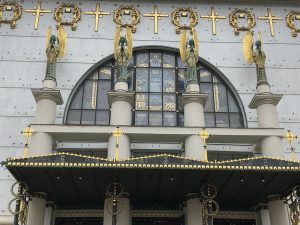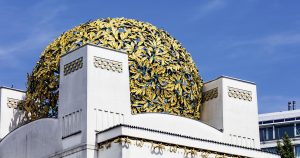Americans are at a disadvantage when answering our title question because the word “secession” is so identified with our Civil War. When eleven southern states each announced that they were seceding from the United States in 1860 and 1861, they initiated this bloody conflict.
In Austria, on the other hand, “secession” had nothing to do with war or politics. It was purely an artistic movement that took place in 1897 when a group of Austrian painters, sculptors, and architects resigned (i.e., “seceded”) from the Association of Austrian Artists. They felt it was their duty to oppose the official domination and conservative outlook of the Vienna Academy of the Arts, the Vienna Künstlerhaus. It was a dramatic step forward that came to include all the arts, including furniture, decorative arts, and ceramics and glass. It is now usually referred to as the “Vienna Secession,” the “Austrian Secession” or, in German, as Wiener Secession or, in some cases, as Vereinigung Bildender Künstler Österreichs (the Union of Austrian Artists), the more formal name of the group of artists who made up the secessionists.

Because the secession movement in Vienna had such significant results and created so much interest (not only at the time but among art history scholars – of which I am not one – over the years), there is a tendency to think that it was an important, one-off phenomenon. And it was important; there’s no doubt about that. Yet when we think about what has happened over the years in all sorts of artistic endeavors, it becomes clear that among artists of all types – not just in the fine arts but in all areas of artistic expression – such reactions and such “looking back” – have not been unusual. When we think about what happened in the other field with which I’m pretty seriously involved – music – we have only to invoke Richard Wagner’s name (and others from even earlier periods in musical history) to realize that moving away from the past and moving on to a “new” type of musical endeavor have together made up an important and convenient way of taking us through the ages and experiences of the art form. And when we think about more recent musical artists (think Philip Glass) we realize that in a relatively short period of time, their work – while still innovative – will probably be relegated in listeners’ imaginations to “accepted” rather than “new.”

Facade with angels
So it is with art and architecture and what we have with the secessionists of Vienna. They were not the first to break away from what painters, sculptors, and architects had created before they came on the scene, but they were explicit as they described what they wanted to do, that it would focus on a different (and perhaps more challenging) role for them as they worked. And they weren’t the first, even with this secessionist activity. Go to Wikipedia and learn about how in Munich, just five years earlier, something along the same lines took place. We learn that:
The Munich Secession was an association of visual artists who broke away from the mainstream Munich Artists’ Association in 1892, to promote and defend their art in the face of what they considered official paternalism and its conservative policies. They acted as a form of cooperative, using their influence to assure their economic survival and obtain commissions.
There were other such situations – preceding and following on throughout art history, I suppose – but it is the timeframe in which so much of this was happening in Vienna (and in Munich and elsewhere) that I find so fascinating. All this was taking place in the second half of the 19th century, going up to (for the most part) the Great War. As we do the math we have the opportunity to conclude that this is a convenient framework for looking at and connecting both Art Nouveau and Secessionism. As we give further thought to what was happening in Secessionism, we realize that, just as in Art Nouveau, much of the impetus came from an almost awesome need to do things with art, decoration, architecture, and other forms that were not connected to (or were built from) what had been done previously. It was a period of time (as I described in More Art Nouveau Notes: Time and Place last May) that while Art Nouveau was flourishing as a “dynamic” force throughout much of Europe, that energy was – according one scholar – contrasted by what he called “reflective maturity” in what was happening in Vienna Secessionism.

Gold Laurel Leaf Dome
To support my agreement with this “reflective maturity” idea, I delightedly offer two examples in the photographs included here, the Vienna Secession Building and the St. Leopold Church in Steinhof. These two structures (about both of which I will be writing later) represent – to me – the simply gorgeous elements we are talking about when we speak about Art Nouveau and Vienna Secessionism. And matching the visual representations shown here, two quotations (for which I have no source, although I remember hearing them said when I was last in Vienna) enable me to make the specific connection. One referred to the elaborate and specially-designed dome of the Secession Building in Vienna as the city’s greatest example of Art Nouveau. The other referred to Otto Wagner’s Church of St. Leopold, built as part of a large psychiatric hospital just outside Vienna, which I heard called “the most beautiful Art Nouveau church in the world.”
Who am I to agree or disagree? Well, in this case I do agree. Even though I have not yet seen and enjoyed looking at every example of Art Nouveau in Vienna or every Art Nouveau church in the world, this is my own personal blog and there’s always one way to bring a discussion to a close (or to segue into the next time I write about the Vienna Secession): “I know what I like.”
[…] earlier touched briefly on the Vienna Secession movement (What is the Vienna Secession? October 29, 2019) and on its connection with Art Nouveau in Vienna (toward the end of More Art […]